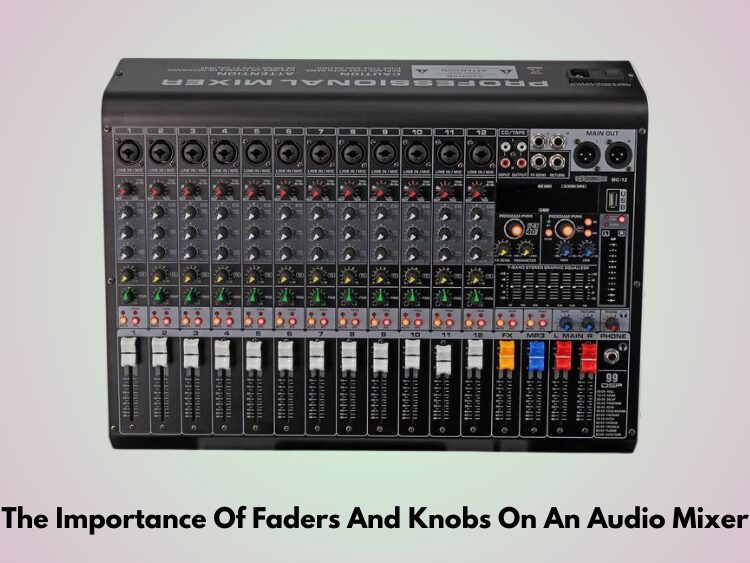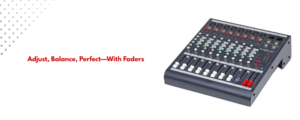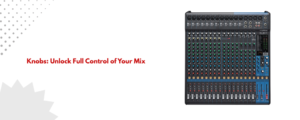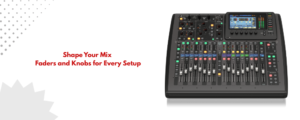People unfamiliar with audio mixers might think they are just a bunch of faders and knobs, but each one is very important for creating sound. Hand-held controls like faders and knobs, let engineers precisely change sound, whether they are in a live setting or a recording studio. If you know what they do, you can improve your mixing skills and get a better sound outcome.
What Are Faders?
The moving controls called faders are usually found at the bottom of the channel strip on an audio mixer. They change how loud an audio input is in the mix as a whole. When you move a fader up, the volume of that channel goes up, and when you move it down, it goes down.
Why Faders Are Important:
- Smooth Volume Adjustments: The main reason why faders are important is that they let you change the volume smoothly during live shows.
- Balance and Blend: These controls help make a well-balanced mix by changing how loud each voice or instrument is.
- Visual Reference: The straight structure lets you see your mix levels quickly.
For instance, a lead voice might be near the front of a mix, which means its fader would be higher. Instruments in the background, on the other hand, might be lower to support the performance. For further guidance on getting the most out of your mixer, check out our detailed guide on how to choose the perfect audio mixer for your needs.
What Are Knobs?
Knobs are circular tools that are all over the mixer’s display. Usually, each button on the channel strip handles a different part of it, like the gain, EQ, pan, or effects passes.
Different Kinds of Knobs and What They Do:
- Gain/Trim Knob: This is at the very top of the channel strip and changes the strength of the input sound. If you set this properly, the sound will be clear and free of distortion.
- EQ Knobs (High, Mid, Low): These change the pitch balance of the sound by raising or lowering certain frequency bands.
- Pan Knob: This control tells the radio system where the sound should be placed—left, right, or in the middle.
- Aux/FX Send Knobs: These direct some of the signal to monitors or other effects.
Each button changes a different part of the sound, so you can fine-tune the tone, arrangement, and processing.
Working Together: Knobs and Faders Get Along
Knobs and faders each control a different part of the sound signal, but they are meant to work together. For example, if you turn the trim knob too far up, the gain will be too high and the slider will not work as well, which will cause distortion. In the same way, bad EQ choices can make you raise the fader when you don’t need to, which can result in a busy or loud mix.
Here’s a Smart Way to Do Things:
- Watch the level meter as you turn the trim knob to set the gain.
- Use the EQ knobs to change the tone and get rid of muddiness or add clarity.
- To spread the instruments and voices out across the sound field, move the pan knob.
- If you want to add echo, delay, or other effects, set the effects sends.
- Set the channel’s volume in the mix with the switch.
When used correctly, faders and knobs give you full control over all parts of your sound, letting you make a professional and musical mix.
What Are Faders and Knobs for Digital and Analog Mixers?
Faders and knobs are real-world settings on analog mixes. These may also be virtual or have more than one use on digital mixes. Depending on your display or wiring, a digital knob could be used to change the gain in one setting and the pan in another. The basic tasks don’t change, no matter the platform, and they’re still not very important.
If you’re considering upgrading to a digital model, make sure to check out our guide on the essential features to look for in an audio mixer to ensure you get the right mix of functionality.
Conclusion
Not only are faders and knobs parts, they are also very important tools for shaping your mix. With faders, you can precisely change the volume, and with knobs, you can finetune the tone, balance, and effects. If you want to make sound that is clean, powerful, and professional, you need to learn how to use them properly. Whether you’re at a show behind a mixing desk or in a studio changing tracks, knowing how to use these tools well can make your whole audio output better.




